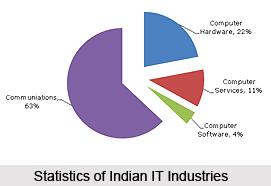 Information Technology in India accounts for a substantial part of the country`s GDP and export earnings while providing employment to a significant number of its associated sectors` workforce. Technically adept immigrants from India sought jobs in the western world from the 1950s onwards as India`s education system produced more engineers than its industry could actually absorb. India`s growing importance in the information age thus enabled it to form close ties with both the United States of America and the European Union.
Information Technology in India accounts for a substantial part of the country`s GDP and export earnings while providing employment to a significant number of its associated sectors` workforce. Technically adept immigrants from India sought jobs in the western world from the 1950s onwards as India`s education system produced more engineers than its industry could actually absorb. India`s growing importance in the information age thus enabled it to form close ties with both the United States of America and the European Union.
Economies of scale for the information technology industry are always high. The marginal cost of each unit of additional software or hardware is inconsequential as compared to the value addition that results from it. Unlike other common industries, the Information Technology in India is knowledge-based. Efficient utilisation of skilled labour forces in the Information Technology sector usually help an economy to achieve a rapid pace of economic growth. The Information Technology in India helps many other sectors in the growth process of the economy including the services and manufacturing sectors.
The computer network in India had evolved into the Internet by 1989, when the total number of users worldwide began to increase. Compared to other communication channels like postal mail or long-distance telephone calls, email via the Internet is quicker, cheaper, and better in other ways. The early 1990s saw a very rapid rate of adoption of the Internet, including the World Wide Web, especially after the development of MOSAIC, which is a software technology that made the Internet much more user-friendly. One reason that the Information Technology and Internet was adopted so rapidly was the widespread prior adoption of personal computers. This spread of the Internet in the 1990s throughout India meant that computers were increasingly used for communication, rather than as only number-crunchers, a radical change from the early functions of mainframe computers.
The Information Technology in India serves as a medium of e-governance, as it assures easy accessibility to information. The use of information technology in the service sector has eventually improved operational efficiency and thus added to transparency. It also serves as a medium of skill configuration. The beginning of Information Technology in India dates back to the times when, the Indian Government acquired the EVS EM computers from the Soviet Union, which were used in large companies and research laboratories. Tata Consultancy Services was then established in 1968 by the Tata Group and they were the country`s largest software producers during the 1960s. As an outcome of the various policies of Jawaharlal Nehru the economically struggling country was able to build a large scientific workforce, and stood second in numbers only to that of the United States of America and the Soviet Union. On 18 August 1951 the minister of education Maulana Abul Kalam Azad, inaugurated the Indian Institute of Technology at Kharagpur in West Bengal. Probably, modeled after the Massachusetts Institute of Technology these institutions were conceived by a 22 member committee of scholars and entrepreneurs under the leadership of N. R. Sarkar. The IITs were envisioned by Prime Minister Jawaharlal Nehru as a means of applying scientific and technological knowledge for India`s industrial development. Engineers were needed to design and operate steel plants, hydroelectric dams, and manufacturing facilities. A foreign university was invited to assist in establishing each IIT.
 The immigration laws in the United States of America (1965) allured many skilled Indian professionals aiming for research. By 1960 as many as 10,000 Indians decided to settle in the US. The reason for this immigration was rooted in India producing more engineers through its education system that was expanded during the 1950s. However, their industries were not able to absorb those many engineers. By the 1980s a number of engineers from India were seeking employment in other countries. In response, the Indian companies realigned wages to retain their experienced staff.
The immigration laws in the United States of America (1965) allured many skilled Indian professionals aiming for research. By 1960 as many as 10,000 Indians decided to settle in the US. The reason for this immigration was rooted in India producing more engineers through its education system that was expanded during the 1950s. However, their industries were not able to absorb those many engineers. By the 1980s a number of engineers from India were seeking employment in other countries. In response, the Indian companies realigned wages to retain their experienced staff.
The National Informatics Centre was established in March 1975. The inception of The Computer Maintenance Company (CMC) followed next in October 1976. Between 1977-1980 the country`s Information Technology companies like Patni Computer Systems, Tata Infotech, and Wipro, had become visible. The `microchip revolution` of the 1980s had convinced both Indira Gandhi and her successor Rajiv Gandhi that electronics and telecommunications were significant to India`s growth and development. MTNL underwent technological improvements. The Indian government created three wide-area computer networking schemes between 1986-1987, namely INDONET (intended to serve the IBM mainframes in India), NICNET (the network for India`s National Informatics Centre), and the academic research oriented Education and Research Network (ERNET).
The happenings of the Information Technology sector in India during the years 1991-2001, proved to be truly noteworthy. The policies of N. Chandrababu Naidu, the chief minister of Andhra Pradesh helped transform Hyderabad into one of the Information Technology hubs of India. Videsh Sanchar Nigam Limited (VSNL) set up Gateway Electronic Mail Service in 1991, the 64 kbit/s leased line service in 1992 and commercial Internet access on a visible scale in 1992. Election results were displayed through National Informatics Centre`s NICNET.
The Indian economy underwent great economic reforms in 1991, leading to a new era of globalisation and international economic integration, all owing to the Information Technology sector. Economic growth of over 6% annually was seen during 1993-2002. The new administration under Atal Bihari Vajpayee placed the development of Information Technology among its top five priorities. His policies formed the Indian National Task Force on Information Technology and Software Development. Within 90 days of its establishment, the Task Force produced an all-embracing background report on the state of technology in India and an IT Action Plan with 108 recommendations. The Task Force acted quickly because it was built upon the experience of state governments, central government agencies, universities, and the software industry. Most of its proposals were consistent with the outlook of international bodies like the World Trade Organization (WTO), International Telecommunications Union (ITU), and World Bank.
Informatisation is the process through which new communication technologies are used in India as a means of furthering socio-economic development. While India as a nation once stood far behind many other countries in its degree of informatisation, the information strategy is today engaged in developing enthusiastically the technopolises like Bangalore and Hyderabad. Information Technology in India can be best described in regards to the working procedure of technopolis. A technopolis is a geographically concentrated high-tech complex characterised by a large number of entrepreneurial spin-off companies. A spin-off is a new company that is created by individuals who leave a parent organization, and work with a technology that the entrepreneurs bring with them from the parent organization. Thus, a high-technology industry is one that is at the cutting edge of technology, an industry whose core working strategy changes rapidly.
The success of Information Technology in India not only had economic consequences but also had far-reaching political reactions. India`s reputation both as a source and a destination for skilled workforce helped the nation to improve its relations with a number of world economies. In contemporary times, the Information Technology sector in India employs an estimated 325,000 people, and needs at least an additional 55,000 every year to keep pace with its goals of expansion. Flexible, need-based, market-driven training and education in computer hardware and software are also offered by several private sector companies outside the purview of universities and colleges. IT training companies in India, such as NUT, Aptech, and ZED, offer Web-based computer training and certification courses and has grown into a business which is growing rapidly.















